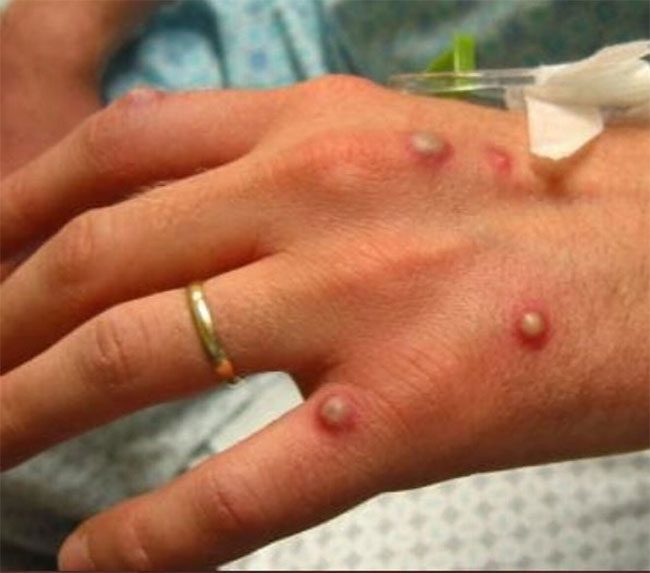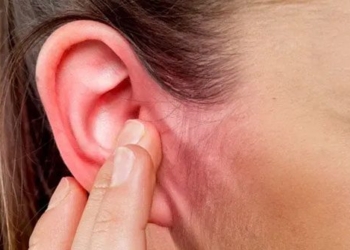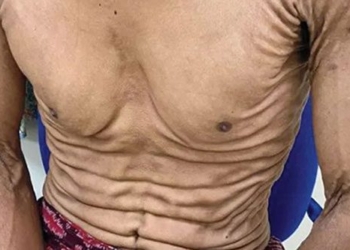On July 29, the Ministry of Health issued guidelines for the diagnosis, treatment, and prevention of monkeypox in humans.
Monkeypox is an acute infectious disease with the potential to cause outbreaks, caused by the monkeypox virus. The disease originates from Africa and is transmitted from animals to humans and from human to human through direct contact with skin lesions, bodily fluids, sexual contact, respiratory droplets, contaminated objects, and from mother to child.
The main symptoms of the disease include fever, rash resembling blisters, and swollen lymph nodes, which can lead to severe complications and even death.
Stages of Monkeypox
The incubation period is 6 to 13 days (ranging from 5 to 21 days), during which infected individuals show no symptoms and cannot transmit the virus.
Initial stage: Lasting 1 to 5 days, characterized by fever and swollen lymph nodes throughout the body. Accompanying symptoms may include headache, fatigue, chills, sore throat, and muscle aches. The virus can be transmitted to others starting from this stage.

The full-blown stage is characterized by the appearance of skin rashes, typically occurring 1 to 3 days after fever. (Illustration)
Full-blown stage: Characterized by the appearance of skin rashes, usually seen 1 to 3 days after fever, with the following characteristics:
- Location: Rashes tend to be centripetal, commonly found on the face, palms, and soles. Rashes may also occur in the mouth, eyes, and genital area.
- Progression of rashes: Sequentially from macules (flat lesions) to papules (raised lesions), then to vesicles (fluid-filled lesions), pustules (lesions filled with pus), crusting, and peeling, which may leave scars.
- Size of skin lesions: Typically ranges from 0.5 to 1 cm.
- The number of skin lesions on an individual can range from a few spots to dense clusters. In severe cases, lesions may merge into larger areas of skin damage.
Recovery stage: Symptoms of monkeypox can last from 2 to 4 weeks and then resolve on their own. Patients will no longer exhibit clinical symptoms, although skin scarring may affect aesthetics, and there is no longer a risk of transmitting the virus to others.
Forms of the Disease
- Asymptomatic form: Individuals infected with the monkeypox virus show no clinical symptoms.
- Mild form: Symptoms usually resolve within 2 to 4 weeks without the need for any specific treatment.
- Severe form: Typically occurs in high-risk groups (pregnant women, the elderly, children, individuals with underlying health conditions, immunocompromised individuals, etc.), and can lead to death, usually from the second week of illness. Patients may experience skin infections, with symptoms including prolonged fever, pus-filled lesions, or ruptured lesions discharging pus.
Some individuals may develop pneumonia (cough, chest tightness, difficulty breathing), encephalitis (reduced consciousness, seizures, confusion, delirium), or septicemia (prolonged fever, damage to internal organs).
Treatment for Monkeypox
The Ministry of Health emphasizes monitoring and isolating suspected/confirmed cases; symptomatic treatment is the primary focus; ensuring nutrition, electrolyte balance, and psychological support. The use of specific antiviral medications should be reserved for severe cases and special populations (infants, the elderly, immunocompromised individuals, etc.) according to the recommendations of the World Health Organization and regulations in Vietnam; monitoring, detecting, and promptly managing severe conditions and complications of the disease.
The Ministry of Health stresses that general treatment measures include isolating suspected and confirmed cases in healthcare facilities according to the temporary guidelines for monitoring and preventing monkeypox issued by the Ministry of Health; specific treatment should be tailored to each patient.
For mild cases, treatment mainly involves symptomatic relief such as fever reduction and pain management; care for skin, eye, and mouth lesions; ensuring nutrition and electrolyte balance; and monitoring for early detection of complications such as pneumonia, skin infections, septicemia, or encephalitis to provide treatment in isolation units in intensive care; preventing and controlling infections according to regulations.
For severe cases, treatment should be conducted in isolation units in intensive care, managing complications (if any) according to established protocols.
Specific antiviral medications are indicated in the following cases:
- Individuals with severe complications (septicemia, pneumonia, encephalitis, etc.).
- Immunocompromised individuals (HIV, cancer patients, those undergoing immunosuppressive therapy or high-dose corticosteroids, etc.).
- Children, especially those under 8 years old.
- Pregnant women or breastfeeding mothers.
- Individuals with progressive acute illnesses.
Medications should be used according to the recommendations of the World Health Organization.





















































